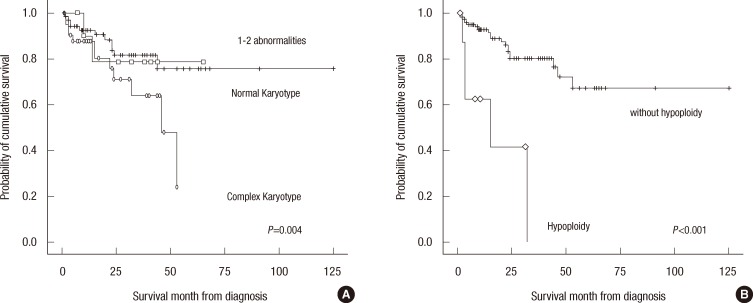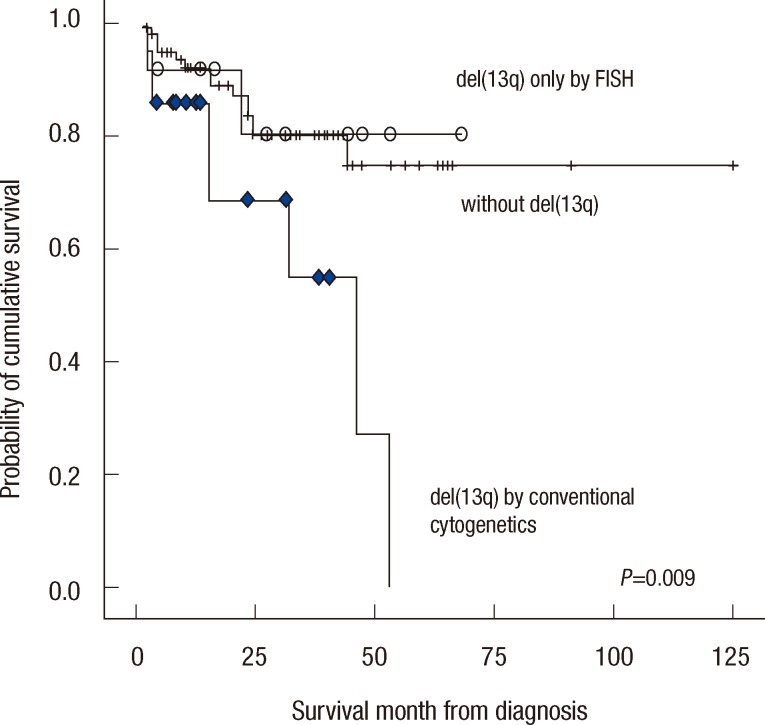Ann Lab Med.
2013 Jul;33(4):248-254. 10.3343/alm.2013.33.4.248.
Impact of Genetic Abnormalities on the Prognoses and Clinical Parameters of Patients with Multiple Myeloma
- Affiliations
-
- 1Department of Laboratory Medicine, Catholic Genetic Laboratory Center, College of Medicine, The Catholic University of Korea, Seoul, Korea. microkim@catholic.ac.kr
- 2Seoul St. Mary's Hospital, College of Medicine, The Catholic University of Korea, Seoul, Korea.
- 3Catholic Hematopoietic Stem Cell Transplantation Center, College of Medicine, The Catholic University of Korea, Seoul, Korea.
- KMID: 1707231
- DOI: http://doi.org/10.3343/alm.2013.33.4.248
Abstract
- BACKGROUND
We reviewed patients with multiple myeloma (MM) in order to assess the incidence of genetic abnormalities and their associations with clinical parameters, risk groups, and prognosis.
METHODS
A total of 130 patients with MM were enrolled. The incidences of genetic abnormalities were determined in all patients. The relationships of the genetic abnormalities and clinical parameters were investigated. In addition, a survival analysis was performed.
RESULTS
Abnormal karyotypes were detected in 42.3% (N=55) of the patients, and this was increased to 63.1% (N=82) after including the results determined with interphase FISH. Hypodiploidy was observed in 7.7% (N=10) of the patients, and all were included in the group with complex karyotypes (30.8%, N=40). The 14q32 rearrangements were detected in 29.2% (N=38) of the patients, and these most commonly included t(11;14), which was followed by t(4;14) and t(14;16) (16.2%, 11.5%, and 0.8%, respectively). Abnormal karyotypes and complex karyotypes were associated with disease progression markers, including low hemoglobin levels, low platelet counts, high plasma cell burden, high beta2-microglobulin, and high international staging system stages. A high free light chain (FLC) ratio and FLC difference were associated with abnormal karyotypes, complex karyotypes, and higher plasma cell burden. Hypodiploidy and low platelet counts were significant independent prognostic factors and were more important in patient outcome than any single abnormality.
CONCLUSIONS
Genetic abnormalities were associated with disease progression markers and prognosis of MM patients.
MeSH Terms
Figure
Cited by 2 articles
-
KRAS, NRAS , andBRAF mutations in plasma cell myeloma at a single Korean institute
Yonggoo Kim, Sung-Soo Park, Chang-Ki Min, Gun Dong Lee, Jungok Son, Sung Jin Jo, Eunhee Han, Kyungja Han, Myungshin Kim
Blood Res. 2020;55(3):159-168. doi: 10.5045/br.2020.2020137.A retrospective analysis of cytogenetic alterations in patients with newly diagnosed multiple myeloma: a single center study in Korea
Shuhua Li, Hyeon-Ho Lim, Kwang-Sook Woo, Sung-Hyun Kim, Jin-Yeong Han
Blood Res. 2016;51(2):122-126. doi: 10.5045/br.2016.51.2.122.
Reference
-
1. Boyd KD, Ross FM, Chiecchio L, Dagrada GP, Konn ZJ, Tapper WJ, et al. A novel prognostic model in myeloma based on co-segregating adverse FISH lesions and the ISS: analysis of patients treated in the MRC Myeloma IX trial. Leukemia. 2012; 26:349–355. PMID: 21836613.
Article2. Kumar SK, Rajkumar SV, Dispenzieri A, Lacy MQ, Hayman SR, Buadi FK, et al. Improved survival in multiple myeloma and the impact of novel therapies. Blood. 2008; 111:2516–2520. PMID: 17975015.
Article3. Avet-Loiseau H, Attal M, Moreau P, Charbonnel C, Garban F, Hulin C, et al. Genetic abnormalities and survival in multiple myeloma: the experience of the Intergroupe Francophone du Myélome. Blood. 2007; 109:3489–3495. PMID: 17209057.4. Greipp PR, San Miguel J, Durie BG, Crowley JJ, Barlogie B, Bladé J, et al. International staging system for multiple myeloma. J Clin Oncol. 2005; 23:3412–3420. PMID: 15809451.
Article5. Wuilleme S, Robillard N, Lodé L, Magrangeas F, Beris H, Harousseau JL, et al. Ploidy, as detected by fluorescence in situ hybridization, defines different subgroups in multiple myeloma. Leukemia. 2005; 19:275–278. PMID: 15538401.
Article6. Cremer FW, Bila J, Buck I, Kartal M, Hose D, Ittrich C, et al. Delineation of distinct subgroups of multiple myeloma and a model for clonal evolution based on interphase cytogenetics. Genes Chromosomes Cancer. 2005; 44:194–203. PMID: 16001433.
Article7. Fonseca R, Bergsagel PL, Drach J, Shaughnessy J, Gutierrez N, Stewart AK, et al. International Myeloma Working Group molecular classification of multiple myeloma: spotlight review. Leukemia. 2009; 23:2210–2221. PMID: 19798094.
Article8. Drach J, Schuster J, Nowotny H, Angerler J, Rosenthal F, Fiegl M, et al. Multiple myeloma: high incidence of chromosomal aneuploidy as detected by interphase fluorescence in situ hybridization. Cancer Res. 1995; 55:3854–3859. PMID: 7641204.9. Avet-Loiseau H, Facon T, Grosbois B, Magrangeas F, Rapp MJ, Harousseau JL, et al. Oncogenesis of multiple myeloma: 14q32 and 13q chromosomal abnormalities are not randomly distributed but correlate with natural history, immunological features and clinical presentation. Blood. 2002; 99:2185–2191. PMID: 11877296.
Article10. Min CK, Lee MJ, Eom KS, Lee S, Lee JW, Min WS, et al. Bortezomib in combination with conventional chemotherapeutic agents for multiple myeloma compared with bortezomib alone. Jpn J Clin Oncol. 2007; 37:961–968. PMID: 18156171.
Article11. Shaffer LG, Slovak ML, editors. ISCN 2009: an international system for human cytogenetic nomenclature. Basel: Karger;2009.12. Ross FM, Avet-Loiseau H, Ameye G, Gutiérrez NC, Liebisch P, O'Connor S, et al. Report from the European Myeloma Network on interphase FISH in multiple myeloma and related disorders. Haematologica. 2012; 97:1272–1277. PMID: 22371180.
Article13. Kumar S, Zhang L, Dispenzieri A, Van Wier S, Katzmann JA, Snyder M, et al. Relationship between elevated immunoglobulin free light chain and the presence of IgH translocations in multiple myeloma. Leukemia. 2010; 24:1498–1505. PMID: 20520636.
Article14. Rajkumar SV. Multiple myeloma: 2012 update on diagnosis, risk-stratification, and management. Am J Hematol. 2012; 87:78–88. PMID: 22180161.
Article15. Kröger N, Schilling G, Einsele H, Liebisch P, Shimoni A, Nagler A, et al. Deletion of chromosome band 13q14 as detected by fluorescence in situ hybridization is a prognostic factor in patients with multiple myeloma who are receiving allogeneic dose-reduced stem cell transplantation. Blood. 2004; 103:4056–4061. PMID: 14982868.
Article16. Christensen JH, Abildgaard N, Plesner T, Nibe A, Nielsen O, Sørensen AG, et al. Interphase fluorescence in situ hybridization in multiple myeloma and monoclonal gammopathy of undetermined significance without and with positive plasma cell identification: analysis of 192 cases from the Region of Southern Denmark. Cancer Genet Cytogenet. 2007; 174:89–99. PMID: 17452249.
Article17. Dewald GW, Therneau T, Larson D, Lee YK, Fink S, Smoley S, et al. Relationship of patient survival and chromosome anomalies detected in metaphase and/or interphase cells at diagnosis of myeloma. Blood. 2005; 106:3553–3558. PMID: 16030187.
Article18. Schmidt-Wolf IG, Glasmacher A, Hahn-Ast C, Jüttner A, Schnurr T, Cremer F, et al. Chromosomal aberrations in 130 patients with multiple myeloma studied by interphase FISH: diagnostic and prognostic relevance. Cancer Genet Cytogenet. 2006; 167:20–25. PMID: 16682281.
Article19. Ross FM, Ibrahim AH, Vilain-Holmes A, Winfield MO, Chiecchio L, Protheroe RK, et al. Age has a profound effect on the incidence and significance of chromosome abnormalities in myeloma. Leukemia. 2005; 19:1634–1642. PMID: 15990862.
Article20. Kumar S, Fonseca R, Ketterling RP, Dispenzieri A, Lacy MQ, Gertz MA, et al. Trisomies in multiple myeloma: impact on survival in patients with high-risk cytogenetics. Blood. 2012; 119:2100–2105. PMID: 22234687.
Article21. Kapoor P, Fonseca R, Rajkumar SV, Sinha S, Gertz MA, Stewart AK, et al. Evidence for cytogenetic and fluorescence in situ hybridization risk stratification of newly diagnosed multiple myeloma in the era of novel therapie. Mayo Clin Proc. 2010; 85:532–537. PMID: 20511484.22. Fonseca R, Barlogie B, Bataille R, Bastard C, Bergsagel PL, Cheis M, et al. Genetics and cytogenetics of multiple myeloma: a workshop report. Cancer Res. 2004; 64:1546–1558. PMID: 14989251.23. Kumar SK, Mikhael JR, Buadi FK, Dingli D, Dispenzieri A, Fonseca R, et al. Management of newly diagnosed symptomatic multiple myeloma: updated Mayo Stratification of Myeloma and Risk-Adapted Therapy (mSMART) consensus guidelines. Mayo Clin Proc. 2009; 84:1095–1110. PMID: 19955246.
Article24. Kapoor P, Rajkumar SV. Update on risk stratification and treatment of newly diagnosed multiple myeloma. Int J Hematol. 2011; 94:310–320. PMID: 22005834.
Article25. Avet-Loiseau H, Garand R, Lodé L, Harousseau J, Bataille R. Intergroups Francophone Myélome. Translocation t(11;14)(q13;q32) is the hallmark of IgM, IgE, and nonsecretory multiple myeloma variants. Blood. 2003; 101:1570–1571. PMID: 12393502.
Article26. Stewart AK, Bergsagel PL, Greipp PR, Dispenzieri A, Gertz MA, Hayman SR, et al. A practical guide to defining high-risk myeloma for clinical trials, patient counseling and choice of therapy. Leukemia. 2007; 21:529–534. PMID: 17230230.
Article27. Butler C, Wolff DJ, Kang Y, Stuart RK, Costa LJ. Association of age with fluorescence in situ hybridization abnormalities in multiple myeloma reveals higher rate of IGH translocations among older patients. Leuk Lymphoma. 2012; 53:2444–2448. PMID: 22574971.
- Full Text Links
- Actions
-
Cited
- CITED
-
- Close
- Share
- Similar articles
-
- Multiple myeloma
- Clinical Application of (18)F-FDG PET in Multiple Myeloma
- Nonsecretory Multiple Myeloma associated with Immune Thrombocytopenia and Complicated by Malignant Ascites
- Continuous Multiple Vertebral Compression Fractures in Multiple Myeloma Patient
- A Case of Multiple Myeloma with Biclonal Gammopathy



